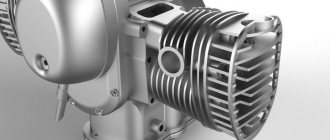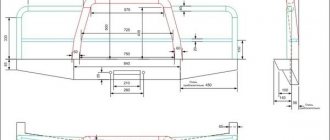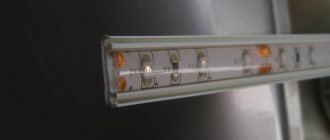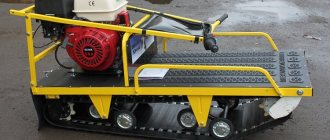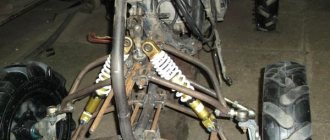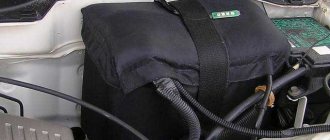Compression in internal combustion engine cylinders is measured using a special device called a compression meter. It is a pressure gauge, the main feature of which is the presence of a free valve. Such a pressure gauge does not release the pressure it receives until the maximum value is recorded at the top dead center of the cylinder. Let's try to figure out how to measure compression in cylinders and how to make a compression meter with your own hands?
Minimum information about compression
For a diesel engine, in which ignition of the fuel occurs under strong compression, the amount of compression plays a decisive role.
Compression is nothing more than the air pressure in the engine cylinder created by the piston during the compression stroke. As a result of the dynamic compression of the air, it heats up, which promotes better combustion of the fuel that is injected (or sucked) into the cylinder. For a diesel engine, in which ignition of the fuel mixture occurs only due to its strong compression, the amount of compression plays a decisive role - the engine simply will not start if it is below a certain norm. A gasoline engine can operate at lower pressure values, but there is also a certain threshold for it. For clarity, imagine a piston with a burnt-out bottom. The mixture expanding upon ignition will not push it, but will simply break into the crankcase. For diesel engines, a compression of at least 28 kg/cm2 is considered normal; it will allow the engine to start at temperatures as low as 15 degrees and develop acceptable power. However, the best indicator will be a pressure of up to 40 kg/cm2 - this is “ideal”, the engine will start in 35-degree frost and the car will have maximum dynamics and traction.
When choosing a pressure gauge, be guided by its operating range - the scale should exceed the compression limits.
For gasoline engines, compression values are much lower - from 12 to 16 kg/cm2 - depending on the engine model. For both internal combustion engines, the difference in values is allowed no more than 3 kg/cm2, and the number of cylinders also matters - a 6-cylinder engine will “swallow” a large spread much more easily than a 4-cylinder engine - the inertia of the mechanisms affects it. To make it easier for you to navigate pressure units when choosing a suitable pressure gauge, we provide data on their comparative values: 1 kg/cm2 = 0.09806 MPa = 0.98067 bar = 14.2233 psi = 100,000 mm water column. = 735.561 mm Hg. = 0.96784 atm. As you can see, the units are easy to convert from one to another, not counting psi and millimeters of water/mercury - they are given in terms of “general information” and are practically not used in technology. If you have not set out to create a perfectly balanced motor, then almost all of these units can be reduced to a “common denominator” - they are practically equal. When choosing a pressure gauge, be guided by its operating range - the scale should exceed the maximum compression values, but at the same time be sufficiently “detailed” in order to compare compression values in different cylinders.
The role of compression in engine performance
The quality of operation of an internal combustion engine depends on many parameters that contribute to the achievement of various parameters: engine power, speed, fuel consumption, throttle response, etc. One of the most important characteristics is engine compression, which, however, is not important in itself, but rather plays a “service” function, helping to determine the technical condition of the cylinder-piston group and assess the correctness of the adjustments of various engine systems.
Engine compression is the pressure of the fuel-air mixture in the combustion chamber at the final stage of the compression stroke (that is, even before the combustible mixture ignites)
It is very important to understand that it is the pressure of the mixture of air and fuel vapor, and not the pressure of the exhaust gases, that pushes the piston down, transferring its energy to it. What does compression mean?
Before talking about the diagnostic functions of engine compression, you need to understand what role it plays in the operation of the engine. As is known, a strictly defined amount of fuel and air is supplied to the engine cylinder, resulting in the formation of an optimal combustible mixture, which releases the maximum amount of energy during combustion. The engine operates efficiently only when the optimal ratio of fuel and air is selected, and every driver knows the consequences of depleting or excessively enriching the fuel mixture - engine performance deteriorates in both cases.
COMPRESSOMETER TEST RESULTS
10th place: “Friend”
Declared manufacturer: Izmerit LLC, Russia
Approximate price: 450 rub.
It's a shame: the only device with detailed instructions, specifications, an "unlimited warranty" - and such a puncture with a check valve: the readings "drain" to zero in just a couple of seconds. Externally, the valve looks like a cheap tire valve, but what if it has different characteristics? And in terms of accuracy, it’s a pretty decent device.
Compressometer "Friend" (diesel)
This universal measuring device can most often be found on the shelves of car dealerships. It is produced at the Izmerit LLC enterprise. Its cost varies, but not more than one thousand rubles. This compression meter took ninth place in the “Behind the Wheel” rating. Detailed instructions included. The manufacturer provides an unlimited warranty. As for accuracy, it is quite high. The only negative is the check valve. The readings of the Friend diesel compression meter drop to zero in just a few seconds. The valve itself is practically no different from a tire valve. It can be slightly modified to provide an accurate, inexpensive and universal solution for measuring compression in a diesel engine.
Compression gauge made from an old spark plug
A drop in compression in engine cylinders not only indicates wear on the pistons or rings, but is also one of the main reasons for a sharp increase in fuel consumption. Therefore, for the purpose of prevention, car owners need to regularly check the technical condition of the engine (gasoline or diesel).
In order not to overpay for this service at a car service center, you can make a measuring device - a compression meter with your own hands from an old spark plug. To assemble a homemade device for measuring compression, you will also need a pressure gauge, a nipple and a piece of metal-plastic tube.
Main stages of work
First of all, using a grinder, you need to cut off the rolling of the core of the old spark plug. We remove the core, then clamp the metal body in a vice or with a clamp, and cut off the “tongue” (side electrode).
You also need to remove the washer. If the washer does not want to unscrew in an amicable way, then this problem can be solved using a more radical method - using an angle grinder with a cutting disc.
By the way, the insulator of an old spark plug can also be used to make various homemade crafts and gadgets. However, the insulator is a rather fragile material, so it must be removed very carefully. You can find out how to do it correctly in this review.
Lightly grind the edges of the nut using sandpaper. Then we drill out the main hole with a drill with a diameter of 9.5 mm. After this, we cut off the back part of the nipple and install the “stub” inside the metal body of the spark plug, having previously lubricated it with an ordinary soap solution.
The resulting workpiece must be pressed into a piece of metal-plastic pipe approximately 20 cm long. And on the other side of the tube, a pressure gauge is attached using a clamp. Watch the video on the website for the manufacturing process of the compression meter.
Similar articles
Top
sdelairukami.ru
Compression measurement of gasoline and diesel engines
The list of general requirements in order to accurately measure compression includes:
- The engine must be warmed up to 80-90 degrees;
- The fuel supply must be turned off;
- All candles without exception must be unscrewed;
- The starter must be absolutely in good working order;
- The battery must be fully charged;
- In the case of a manual gearbox, you can engage the upper (over) gear and also prevent the vehicle from moving. To do this, use the parking brake and/or wheel chocks. It is also possible to measure compression in the “neutral” position of the manual transmission lever. In cars with an automatic transmission, the selector is set to parking mode (P).
- The next step is to check the condition of the air filter. Before measuring compression, a dirty filter is replaced with a new one. The second method is to temporarily disconnect the air supply line from the inlet.
- In gasoline internal combustion engines, the ignition system will need to be turned off. To do this, it is necessary to disconnect the wiring from the breaker to supply low voltage, which is supplied to the ignition coil. Motors equipped with an ignition distributor will require removal of the main high-voltage wire from the coil. The specified wire is then connected to ground.
- To effectively shut off the fuel supply in designs that include a mechanical fuel pump, the fuel line will need to be disconnected. Next, the pipe is turned off. For an electric fuel pump, it will be enough to remove the contact from its relay.
- Afterwards, the places for installing the spark plugs are cleaned of dirt and the tips of the high-voltage wires are removed from the spark plugs. Then the candles are unscrewed.
- With the spark plugs removed, you will need to turn the engine over several times with the starter. The procedure is necessary to clean the cylinders from possible carbon deposits and other deposits.
- The last step is to connect the compression gauge to the spark plug well of the cylinder. It is better to measure compression with a partner who will press the accelerator pedal all the way. The gas pedal is depressed so that the compression measurement is carried out with the throttle valve open, and due to this, the intake resistance is reduced. With the pedal depressed, the engine is turned with the starter for about 5 seconds. It is necessary to monitor when the highest value appears on the scale. The indicated value is noted and further measurements are taken in other engine cylinders.
As for the features of measuring compression on a diesel engine, then:
- Turning off the fuel supply in a diesel engine is achieved by pressing down the cut-off lever. This lever is located on the injection pump. The second way is to turn off the solenoid valve, which will also block the fuel supply to the diesel internal combustion engine. This valve is located on the fuel line, which is responsible for supplying fuel.
- The compression gauge in a diesel engine is connected through the holes of the injectors or glow plugs. This depends on which elements are more convenient to reach, as well as according to the recommendations for a particular type of diesel engine.
- To measure compression on a diesel engine, you will need a special compression meter, which will have an appropriate tip for secure fastening in the hole of the injector or glow plug. The maximum measurement threshold for such a compression meter for a diesel engine should be higher compared to its gasoline counterpart. A diesel compressometer should be able to record a pressure of about 60 atmospheres.
- When measuring diesel compression, there is no need to press the gas pedal. The fact is that most diesel engines do not have a throttle valve. Only diesel engines that have a special valve in the intake stand separately. The valve is necessary to create vacuum. The vacuum will ensure the functionality of the vacuum regulator and brake booster.
The fuel supply must be turned off so that the fuel does not wash away the so-called oil wedge. To stop the fuel supply, you can use one of the listed methods to turn off the fuel pump, fuel injection pump or injectors. The spark plugs must be unscrewed.
If you take measurements by unscrewing only the spark plug in one cylinder, then there is a noticeable increase in the resistance to crankshaft rotation. When the starter cranks, this resistance leads to a decrease in speed. If the battery is faulty or has a weak battery, you can use a jump starter, although this method is not recommended.
Device
The compression gauge for diesel and gasoline is practically the same in design. The device provides a pressure gauge equipped with a shut-off valve and a connecting hose. The device comes with a set of adapters. The measurement process is carried out due to the presence of this valve - thanks to it, a “memory” of maximum indicators is preserved, which can only be recorded within tenths of a second.
After the measurements, the compression value will appear on the pressure gauge dial, by which you can judge the degree of wear of the CPG parts. During the measurements, not only the compression level in each cylinder is assessed, but also their average value.
Manufacturing a compression tester
Many car owners encounter problems with engine operation and insufficient pressure in the cylinders. This is often observed on worn-out engines, and the repair consists of a complete restoration of the engine. It is difficult to determine the pressure yourself without using special equipment. As a result, you have to take the car to a service center and perform expensive diagnostics.
At the same time, car owners can easily make simple devices for checking compression from a regular old spark plug. This will allow you to independently diagnose the engine in the future, saving on contacting specialists. For this work you will need a metal saw or grinder, a wheel nipple, plastic tubes, clamps, sealant and a pressure gauge.
Using a file or grinder, cut off the rolling of the core and the metal tongue. Using a grinder, the surface is processed so that later a nipple can be inserted into the candle. On the reverse side, a plastic tube is placed on the candle, the length of which is about 20 centimeters. It should be seated on a sealant; additional clamps are also used to ensure complete tightness and the ability to withstand high pressure.
A pressure gauge is placed on the spark plug through a tube, which can be purchased at any specialized stores. Such a pressure monitoring device will be quite accurate, so it can be used to easily measure compression in a car engine. At the same time, it will cost much less than ready-made devices, without losing at all to them in the quality and accuracy of the data obtained.
Video - How to make a homemade compression gauge
This is how you make a compression meter yourself. This device will help you save significantly on professional tools and achieve approximately the same result at minimal cost.
If just recently the car’s engine was working properly - fuel and oil consumption, as well as power were within normal limits, but then everything became completely the opposite, then it’s time to check the pressure in the engine cylinders. As you know, a drop in compression is not the best sign for any engine, since the fuel supplied there does not burn completely and remains in the form of sediment, which can cause defects on both the cylinders and pistons.
How to find out compression?
As you already understood, in order to measure compression, you need to purchase a compression meter. After this, it is necessary to perform a number of special actions so that the readings are as accurate as possible and have minimal deviations.
- The engine must be warmed up to operating temperature. This is the time when it can work at full capacity. Then turn it off.
- While the engine is warm, you need to turn off the fuel pump. If you have an injection engine, then you just need to disconnect the special plug designed to power the fuel pump. In the case of a carburetor, disconnect the hose going from the gas line to the fuel pump and the hose on the carburetor float chamber. To prevent the ignition coil from burning out, disconnect the terminal from it.
- Remove all spark plugs. Many drivers make the common mistake of removing only one spark plug. Doing this is strictly prohibited!
- Now screw the compression gauge into one of the spark plug holes. It is recommended to immediately purchase attachments that are designed for mounting on different engines.
- Ask your partner to get into the car and press the gas pedal all the way. This is done to ensure that the throttle valve is open. Then, he must turn on the starter for 2 seconds.
- Readings are taken from the compression gauge, and this procedure is applied to the remaining cylinders. Operating standards can be found in the technical literature for your vehicle.
- Based on the deviations from the norm obtained during measurements, one can judge the type and scale of the malfunction that affected the engine of your car.
Do-it-yourself compression tester for diesel engines
Before you start making a compression gauge for a diesel engine with your own hands, you should consider a few points:
- the pressure gauge must have a scale “with a margin” - its limit must be at least 50 kg/cm2;
- the check valve (what it is needed for, we’ll say later) must maintain the pressure corresponding to normal compression.
What is a check valve for?
A check valve is necessary to record the compression meter readings, which are then reset by opening the valve.
The fact is that, in fact, a compression gauge is an ordinary pressure gauge that is capable of “holding” readings thanks to a check valve - otherwise, when the air injection stops or it is simply disconnected, the instrument needle will fall to “0”. The compression meter shows the maximum pressure pumped into the cylinder, and its readings are reset by pressing the check valve from the outside. However, you can measure the compression by calling someone for help who will turn the ignition key to start. Meanwhile, you can evaluate the compression, so to speak, “in real time” - by directly observing the device.
How to make a compression gauge with your own hands from a glow plug
To do this, you need to use an old candle as an adapter. Measuring compression on a diesel engine without ensuring proper cylinder tightness will not give an accurate picture - pressure losses will be large. You can solve the problem in different ways:
- build a check valve directly into the spark plug, having previously removed the “internals” from it – the spiral and the insulator;
- install the check valve by securing it at the inlet of the pressure gauge, but in this case you will have to disconnect the hose each time to reset the readings;
- You can attach a threaded tube to the opposite end of the spark plug to lengthen the spark plug itself, and build the valve into the threaded end of the hose from the pressure gauge, or do without it altogether.
Analysis of factors influencing the accuracy of compression meter data
Before you start checking the engine, you need to understand what factors affect the accuracy of the device data.
- The crankshaft rotation speed is one of the main conditions for the process of correctly measuring compression. The crankshaft speed should be in the range of 200 - 250 rpm. This indicator directly depends on the state of charge of the battery, the working order of the starter and the condition of the CPG. Using the wrong oil will also affect the crankshaft speed at startup.
- Resistance to air movement in the intake system. The compression characteristics depend on the condition of the air supply system. A dirty air filter, carbon deposits in the intake manifold, malfunction of the air damper are the reasons why the filling of the cylinders with air decreases, which leads to a decrease in pressure in the combustion chamber.
- Valve timing ratio. To reduce the possibility of errors when diagnosing the technical condition of the CPG and valves, before checking the compression, you need to make sure that the valve clearances are set correctly, check the condition of the timing mechanism cams, and the timing belt tension.
Required parts for this device
Before you understand how to make a compression gauge with your own hands, you need to clearly understand what parts are needed in this case. Below we present to you a list of the full range of necessary parts:
In this case, a device such as a pressure gauge is very important. But you need to know that the range of its direct measurement should vary by about - up to 30 kgscm 2.
An adapter that will be made of brass or copper.
To produce such a device with your own hands, you will also need valves, but they must be from a truck camera. Their number is two.
There should also be a tube, the diameter of which varies from 10 to 15, and at the same time it is made of copper or brass.
The tee also has a place on this list. Its internal diameter should vary and not go beyond clearly established limits - 8-10 millimeters.
Rubber nozzle. In order not to spend a long time looking for such an element, we give you directions. A rubber nozzle can be a high-pressure hose and a number of adapters.
To carry out the actual work of collecting this material into a single mechanism, a soldering iron will help us.
A burner that operates using gas.
The so-called rosin.
Compression measurement: without a compression meter or using special equipment
So, in practice, only two methods are actively used that allow compression measurements to be taken:
- using a compression gauge;
- compression measurement by hand;
Naturally, the presence of a device allows you to obtain the most accurate readings, however, in emergency cases or to obtain approximate estimated results, the decision to measure compression manually is also practiced.
Let us immediately note that in order to measure compression without instruments, certain skills and knowledge will be required, and the operation does not present any great difficulties, even for novice car enthusiasts.
- First you need to unscrew the spark plugs, leaving only the spark plug in the first cylinder.
- Then the crankshaft must be turned so that the piston in the first cylinder is at the end of the compression stroke.
- To accurately determine that the piston is in the correct position, you need to check the marks.
- Next, you should approximately remember with what force the crankshaft was turned by hand.
- After this, the spark plug is screwed into the second cylinder and so on.
The main task is to identify the problematic cylinder when, after screwing in the spark plug, the crankshaft rotates most easily (with the least effort). In other words, if the compression is low in one cylinder, then the effort required to turn the crankshaft will be less compared to checking the compression of other cylinders.
Note that although the method is quite primitive, in some cases even it allows you to get a general idea and identify a problem in a particular engine cylinder. More accurate measurements can only be made using a compression gauge.
First of all, you need to study the technical documentation in relation to the specific type of internal combustion engine installed on the machine. Having determined the specific compression value for the engine, you need to start the engine and warm it up until it reaches operating temperature (the cooling fan turns on). Then carefully unscrew the spark plugs
Next, you need to invite an assistant who will depress the gas pedal (an important condition when measuring compression) and crank the engine with the starter. If we talk about the device, the compression gauge has a special tip that is tightly inserted into the spark plug hole. After this, the engine is cranked by the starter for about 3-4 seconds. It is also important to take into account that you need to measure compression provided that the battery is charged and the starter itself is fully operational
The fact is that insufficient crankshaft rotation speed can lead to a noticeable decrease in performance, but this will not mean that the compression in the engine has dropped so much. Then, when the readings have been obtained, they need to be compared with the nominal values for a particular engine.
Let’s also add that the difference in compression readings across all cylinders (data spread) should not be more than 1/10 of the maximum value. This means that if in any cylinder the compression has dropped by 15-20% compared to the others, then there is a high probability that the piston and piston rings are worn out, the timing valves are damaged, etc.
It is also important to understand that it is not recommended to continue operating an engine in which compression is reduced in one or more cylinders for a long time. The fact is that the parts in this cylinder will wear out even more, the engine itself will vibrate more strongly and operate unstably, unburned fuel will flow into the oil pan in excess, which will cause dilution of the oil, thereby increasing the overall wear of the internal combustion engine, etc.
Operating principle
The diesel-gasoline compression meter works very simply. To begin work, the equipment will be connected to the engine cylinder through the hole of a spark plug or injector. The pressure created in the cylinder is then supplied to the pressure gauge through the open valve. When the pressure in the cylinder decreases, the shut-off valve closes. This happens automatically. The valve maintains pressure in the hose or tube, which allows you to evaluate compression indicators. After completing the measurements, the pressure is released by pressing the button.
The procedure for taking measurements
Before checking engine compression, it is necessary to ensure that the battery is fully charged and the starter is working properly. Otherwise, you will get underestimated indicators and start repairing the power unit instead of continuing diagnostics and looking for other reasons.
What is the normal compression in the cylinders of an 8 valve VAZ-2114 engine?
There are several ways to measure pressure - “cold”, “hot”, with the throttle closed and fully open. Practice shows that the most accurate results are obtained by checking on a warm engine, performed according to the instructions:
- Start the engine and bring the coolant temperature to 70 °C.
- Remove the high-voltage wires and turn out all the spark plugs and, on a diesel engine, the injectors.
- Disconnect the injectors from the controller by disconnecting the corresponding connector. Another option is to turn off the power to the fuel pump by removing the required fuse.
- Screw the compression gauge nozzle into the hole of the 1st cylinder, open the throttle valve by pressing the gas pedal, and turn the crankshaft with the starter 5–10 times.
- Take readings and repeat the operation on the remaining cylinders.
If you do not want to touch the electronics, then you don’t have to turn off the injectors of the gasoline engine; this will not affect the accuracy of the readings, but during diagnostics a small amount of fuel will enter the oil sump. The fuel supply on a diesel engine with a mechanical injection pump is turned off using the cut-off lever.
Based on the measurement results, the following conclusions are drawn:
- If the measurement values differ by no more than 1 bar and are close to optimal, the piston group and valves are in good condition.
- The same situation, but the indicators are close to the minimum threshold. The resource of the power unit is almost exhausted, you can drive further and add oil, but prepare for repairs.
- When the pressure in one of the cylinders is 2-3 bar lower than the others, check again by pouring 5 ml of engine lubricant into the spark plug hole. If the compression has increased, this means that the piston group is faulty, since the oil has sealed the fit of the rings. The readings remained the same - a burnt valve was to blame.
If the pressure in all cylinders is below normal, a major overhaul will have to be done. It is useless to carry out a test with adding oil - the engine still needs to be disassembled.
Compression measurement on an injection gasoline engine.
The compression of a diesel engine is the main indicator of its health. Compression is the maximum value of pressure created in the cylinder when the piston is at TDC (top dead center). The design features of diesel engines are such that the slightest deviation of compression from the norm leads to malfunctions of the power unit.
An underestimated pressure indicator entails a complete failure of the cylinder. If a malfunction occurs or the diesel engine is started and the engine is running, it is necessary to carry out a thorough compression check. Pressure diagnostics are carried out according to the instructions supplied with the device.
Technical characteristics of internal combustion engines contain information about a design parameter - the compression ratio, which is a constant value. The compression ratio of a diesel engine is presented as the ratio of cylinder volumes when the piston is located at BDC (bottom dead center) and at TDC, respectively.
The compression ratio can be determined by dividing the cylinder volume by the volume of the combustion chamber. The result obtained after division indicates how many times the volume of the air-fuel mixture decreases when the piston moves from the bottom point to TDC.
The main characteristic of a diesel engine is compression in the cylinders, because only when the operating pressure reaches a certain value does the temperature of the compressed air rise and the air-fuel mixture ignites.
What is the difference between compression gauges for gasoline and diesel engines?
Compression gauge, what to buy?
compression gauge in a case, Licota I talked in detail about this situation and manufacturers in the article about a torque wrench . There are a lot of brands and manufacturers and you just need to know what is good and what is bad. Mostly products from the Chinese-Asian region are presented. There is no need to be afraid, Taiwanese manufacturers make very good devices with a good price-quality ratio. For private craftsmen and semi-professional use, the Licota compression meter is quite suitable. I won’t praise it too much, it’s just an honest product. You will find exactly the same device in Jonnesway boxes, only more expensive. I myself use JTC compression gauges; they are already more suitable for constant long-term use. I don’t recommend “as if” Russian brands. The task is one, make it cheaper at a Chinese factory, and sell it “like everyone else.” And if it still works on oil nipples, cheap sets of keys or light bulbs, then with measuring instruments it’s a waste of money.

